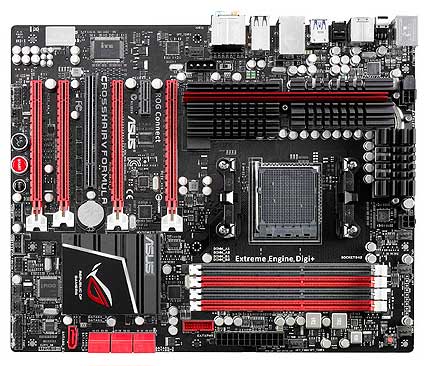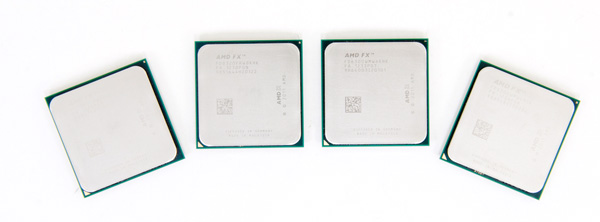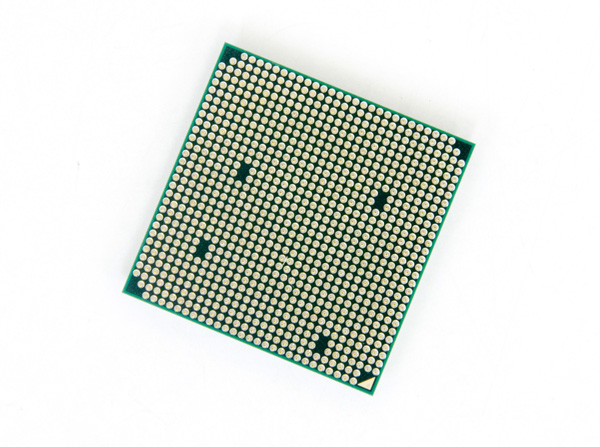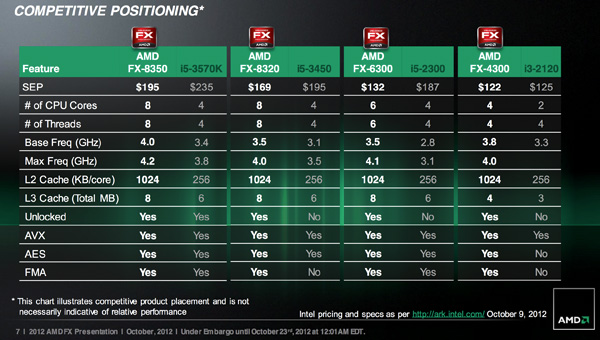The Vishera Review: AMD FX-8350, FX-8320, FX-6300 and FX-4300 Tested
by Anand Lal Shimpi on October 23, 2012 12:00 AM ESTLast year's launch of AMD's FX processors was honestly disappointing. The Bulldozer CPU cores that were bundled into each Zambezi chip were hardly power efficient and in many areas couldn't significantly outperform AMD's previous generation platform. Look beyond the direct AMD comparison and the situation looked even worse. In our conclusion to last year's FX-8150 review I wrote the following:
"Single threaded performance is my biggest concern, and compared to Sandy Bridge there's a good 40-50% advantage the i5 2500K enjoys over the FX-8150. My hope is that future derivatives of the FX processor (perhaps based on Piledriver) will boast much more aggressive Turbo Core frequencies, which would do wonders at eating into that advantage."
The performance advantage that Intel enjoyed at the time was beyond what could be erased by a single generation. To make matters worse, before AMD could rev Bulldozer, Intel already began shipping Ivy Bridge - a part that not only increased performance but decreased power consumption as well. It's been a rough road for AMD over these past few years, but you have to give credit where it's due: we haven't seen AMD executing this consistently in quite a while. As promised we've now had multiple generations of each platform ship from AMD. Brazos had a mild update, Llano paved the way for Trinity which is now shipping, and around a year after Zambezi's launch we have Vishera: the Piledriver based AMD FX successor.
At a high level, Vishera swaps out the Bulldozer cores from Zambezi and replaces them with Piledriver. This is the same CPU core that is used in Trinity, but it's optimized for a very different purpose here in Vishera. While Trinity had to worry about working nicely in a laptop, Vishera is strictly a high-end desktop/workstation part. There's no on-die graphics for starters. Clock speeds and TDPs are also up compared to Trinity.
| CPU Specification Comparison | ||||||||
| CPU | Manufacturing Process | Cores | Transistor Count | Die Size | ||||
| AMD Vishera 8C | 32nm | 8 | 1.2B | 315mm2 | ||||
| AMD Zambezi 8C | 32nm | 8 | 1.2B | 315mm2 | ||||
| Intel Ivy Bridge 4C | 22nm | 4 | 1.4B | 160mm2 | ||||
| Intel Sandy Bridge E (6C) | 32nm | 6 | 2.27B | 435mm2 | ||||
| Intel Sandy Bridge E (4C) | 32nm | 4 | 1.27B | 294mm2 | ||||
| Intel Sandy Bridge 4C | 32nm | 4 | 1.16B | 216mm2 | ||||
| Intel Lynnfield 4C | 45nm | 4 | 774M | 296mm2 | ||||
| Intel Sandy Bridge 2C (GT1) | 32nm | 2 | 504M | 131mm2 | ||||
| Intel Sandy Bridge 2C (GT2) | 32nm | 2 | 624M | 149mm2 | ||||
Vishera is still built on the same 32nm GlobalFoundries SOI process as Zambezi, which means there isn't much room for additional architectural complexity without ballooning die area, and not a whole lot of hope for significantly decreasing power consumption. As a fabless semiconductor manufacturer, AMD is now at GF's mercy when it comes to moving process technology forward. It simply has to make 32nm work for now. Piledriver is a light evolution over Bulldozer, so there's actually no substantial increase in die area compared to the previous generation. Cache sizes remain the same as well, which keeps everything roughly the same. These chips are obviously much larger than Intel's 22nm Ivy Bridge parts, but Intel has a full node advantage there which enables that.
Piledriver is a bit more power efficient than Bulldozer, which enables AMD to drive Vishera's frequency up while remaining in the same thermal envelope as Zambezi. The new lineup is in the table below:
| CPU Specification Comparison | ||||||||||
| Processor | Codename | Cores | Clock Speed | Max Turbo | L2/L3 Cache | TDP | Price | |||
| AMD FX-8350 | Vishera | 8 | 4.0GHz | 4.2GHz | 8MB/8MB | 125W | $199 | |||
| AMD FX-8150 | Zambezi | 8 | 3.6GHz | 4.2GHz | 8MB/8MB | 125W | $183 | |||
| AMD FX-8320 | Vishera | 8 | 3.5GHz | 4.0GHz | 8MB/8MB | 125W | $169 | |||
| AMD FX-8120 | Zambezi | 8 | 3.1GHz | 4.0GHz | 8MB/8MB | 125W | $153 | |||
| AMD FX-6300 | Vishera | 6 | 3.5GHz | 4.1GHz | 6MB/8MB | 95W | $132 | |||
| AMD FX-6100 | Zambezi | 6 | 3.3GHz | 3.9GHz | 6MB/8MB | 95W | $112 | |||
| AMD FX-4300 | Vishera | 4 | 3.8GHz | 4.0GHz | 4MB/4MB | 95W | $122 | |||
| AMD FX-4100 | Zambezi | 4 | 3.6GHz | 3.8GHz | 4MB/4MB | 95W | $101 | |||
The table above says it all. TDPs haven't changed, cache sizes haven't changed and neither have core counts. Across the board Vishera ships at higher base frequencies than the equivalent Zambezi part, but without increasing max turbo frequency (in the case of the 8-core parts). The 6 and 4 core versions get boosts to both sides, without increasing TDP. In our Trinity notebook review I called the new CPU core Bulldozed Tuned. The table above supports that characterization.
It's also important to note that AMD's pricing this time around is far more sensible. While the FX-8150 debuted at $245, the 8350 drops that price to $199 putting it around $40 less than the Core i5 3570K. The chart below shows where AMD expects all of these CPUs to do battle:
AMD's targets are similar to what they were last time: Intel's Core i5 and below. All of the FX processors remain unlocked and ship fully featured with hardware AES acceleration enabled. Most Socket-AM3+ motherboards on the market today should support the new parts with nothing more than a BIOS update. In fact, I used the same ASUS Crosshair V Formula motherboard I used last year (with a much newer BIOS) for today's review:

The Test
For more comparisons be sure to check out our performance database: Bench.
| Motherboard: | ASUS Maximus V Gene (Intel Z77) ASUS Crosshair V Formula (AMD 990FX) |
| Hard Disk: | Intel X25-M SSD (80GB) Crucial RealSSD C300 OCZ Agility 3 (240GB) Samsung SSD 830 (512GB) |
| Memory: | 4 x 4GB G.Skill Ripjaws X DDR3-1600 9-9-9-20 |
| Video Card: | ATI Radeon HD 5870 (Windows 7) NVIDIA GeForce GTX 680 (Windows 8) |
| Desktop Resolution: | 1920 x 1200 |
| OS: | Windows 7 x64/Windows 8 Pro x64 |













250 Comments
View All Comments
frozen ox - Tuesday, October 23, 2012 - link
Yes please! This is the only reason I even read reviews about CPUs with more than 4 cores.JohanAnandtech - Tuesday, October 23, 2012 - link
What kind of usage scenarios are you thinking off? Because virtualizaiton benches are very prominent in our AT Opteron reviews.Virtualization on top of the desktop is rarely done to run heavily loads AFAIK.
sep332 - Tuesday, October 23, 2012 - link
I do keep some VMs running on my desktop but they are not generally loaded. I'm assuming, because of the power draw, these would not be a good choice for a dedicated VM server build?MySchizoBuddy - Tuesday, October 23, 2012 - link
Can they do opencl like the Intel counterpart?Ryan Smith - Tuesday, October 23, 2012 - link
Keep in mind that Vishera doesn't have an on-die GPU. OpenCL can run on the GPU or the CPU (with the appropriate ICDs), but we're almost always talking about GPU execution when we're talking about OpenCL.Beenthere - Tuesday, October 23, 2012 - link
Test after test by many reviewers using real apps, not synthetic benches which exaggerate RAM results, has shown that DDR3 running at 1333-1600 MHz. shows no system bottleneck on a typical Intel or AMD powered desktop PC. Even when increasing the RAM frequency to 2600 MHz. there was no tangible gains because the existing bandwidth @ 1333 MHz. is not saturated enough to cause a bottleneck. APUs do show some GPU benefit with up to 1866 MHz. RAM.fredbloggs73 - Tuesday, October 23, 2012 - link
Hey Anand, great review!Can we please some undervolting results of the FX-8350 like the i7-3770k undervolting article?
Thanks
dishayu - Tuesday, October 23, 2012 - link
It's absolutely ridiculous that even though AMD has pushed out quite a nice and competitive product (in that price range), Intel has gotten wayy too big in the past 6 years that AMD was sleeping and i don't think they'll be pressured to do any price cuts still. So, even though we still have so-called-competition, Intel has a virtual monopoly and i can't hope that the new AMD releases will help drive prices down any more.dishayu - Tuesday, October 23, 2012 - link
Additional thought : I do believe that apart from the power consumption, AMD has a more overall compelling processor with the 8350. Single thread performance has already long crossed the point where you could tell the difference in experience between AMD and Intel (the exception to this is gaming). And AMD is better in heavily threaded applications.So, IF ONLY they could fix the power problem, i wouldn't hesitate to recommend an AMD system for any other purpose than gaming. Just my 2 cents.
figus77 - Tuesday, October 23, 2012 - link
But really... even in games where is the bottleneck with an FX?Remember than in 99% on monitor youìve got a 60hz refresh rate and you can't see more than 60 without glitches fps on that screen, so what's the difference beetween 85 or 95 fps??
I've got an FX8120@3.6ghz with an hd6950@6970 really i can't find a single game that didn't run smooth in 1920x1080 and playing to skyrim with 4 core allocated to the game while 2 pairs of other core are doing video processing on 2 anime episodes is pleasing :-)